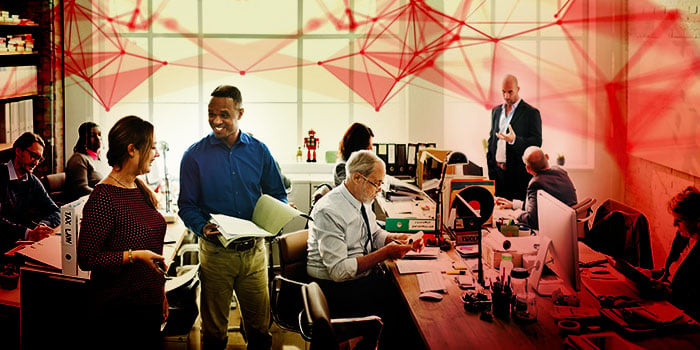As Generation Z enter the workforce, businesses may soon find themselves managing up to five generations of personnel. These employees all have their own work styles, communication preferences and expectations of the workplace. While multigenerational employees may have coexisted for decades, unprecedented advances in technology have resulted in distinctly different approaches to performing work tasks.
Companies must take these differences into account when contemplating any form of digital change or digital transformation if they wish to nurture an efficient work environment, advises Odette Pieters, Director at FlowCentric Technologies.
Much has been written and many myths have circulated about each generation, but one thing is self-evident: technology has changed us all. As if rapidly changing global policies and economic flux weren’t making commerce challenging enough, companies also need to contend with the relentless pace of technological change.
Multigenerational Workforce: Choose Your Tools Wisely
It is vital that organisations ensure their people, processes and systems are connected in ways that resonate with their employees, advises Pieters. If a company makes its processes needlessly complex, employees will find ways to bypass the procedures; and if systems are cumbersome, people will turn to their personal devices for solutions.
Smartphones and Instant Access To Data
These days, most of our workforce carry around their own powerful little computers, otherwise known as smartphones and tablets. These devices grant them access to thousands of applications and terabytes of data on any given day. With better coverage and lower Internet costs, people have easy access to more information than ever before. A simple search engine query can deliver instant answers, or a free app download can allow you to edit data with a few swipes of your finger. When people have all this power within their grasp, is it surprising that users expect to "work smarter, not harder"?
Personal devices have made people more aware of their experience while navigating software. As a result, usability is more important than ever, Pieters explains. Strategic digital change must be supported by an elegant user experience if it is to succeed.
Pieters cautions that each generation may have a different perception of value and varying opinions of what makes a system user-friendly.
“It is important for organisations to strike a balance between providing the right technology for their people and successfully managing enterprise risk,” she says.
While it’s true that each generation may have a unique approach to executing tasks, most deplore inefficiencies and find bureaucracy rather tedious. Generally speaking, employees want to perform their tasks rapidly and efficiently. None of them wants to waste time swapping between numerous applications or searching through server folders and piles of paper to find the information that they need.
In the Age of Instant, users quickly become frustrated with disjointed systems, hard-to-find data or cumbersome systems. Older users may resist learning how to use multiple different systems, while younger employees may find the speed and lack of transparency of current processes frustrating.
If users view their personal devices as better suited to improve their efficiency than their company’s infrastructure, they won’t hesitate to use their phones and accompanying apps to complete their tasks. When users view corporate procedures as a bureaucratic maze that does nothing but prolong their workday, they will undoubtedly find shortcuts and loopholes.
No group can claim the moral high ground on this one. The most significant differences between the generations are the tools that they use to game the system. Why does this matter? Because data matters.
Consider these points in relation to your own company:
- Security: Not all phones or apps are built equally; some have serious vulnerabilities. How many users would truly do their homework before setting up a device or tapping the install button on an app store?
- Control: How can your company manage the data that belongs to it, when that data doesn’t reside on any of its assets?
- Risk: How will your company retrieve this data if the personal device is lost, the app designer goes out of business, or the employee leaves the company? What legal rights will your company have to data that resides on a private device?
- Analyses: How can your company mine its data for trends, statistics or reports if its data is scattered across various platforms, utilising different applications and different naming conventions for the same products?
- Productivity: Can teammates access the data that they need? Will everyone in your multigenerational workforce be able to seamlessly bounce between apps to perform their work?
Does That Mean Old School Rules?
No, technology is changing the way that all people work regardless of their demographics. Employers must provide staff with the appropriate tools they need to complete their work. Failing to do so will result in inefficiencies, control issues and disgruntled employees.
Can you drive successful digital transformation with a multigenerational workforce?
“The psyche of change is often underestimated during digital transformation projects,” says Pieters. She explains that generational differences are often related to:
- Different styles of communication: a formal email versus an emoticon-filled text;
- Device preference: laptop, tablet, mobile;
- Speed and flexibility: working remotely, computing rapidly.
While these differences need to be considered, they are not insurmountable. It is change, in and of itself, which employees find the most daunting.
There are four basic conditions necessary before employees change their behaviour, regardless of their demographic:
- A compelling story: Employees must understand the reason for the change and agree with it.
- Role models: People are more willing to change when they see individuals they admire using new methods, which is why executive buy-in is critical to the success of any meaningful digital project.
- Reinforcing mechanisms: Policies, processes, systems and incentives must all align with and support the objectives of the transformation project.
- Capability development: Employees must have the skills needed to successfully transform with the business.
“To ensure that your company performs better than its competitors, it is critical to invest in technology training,” Pieters emphasises.
While generations may work and use technology differently, Pieters cautions against allowing your workforce to use separate technologies as this will certainly lead to mistakes and a breakdown in communication. Rather identify the generational differences and play to their strengths.
Not all baby-boomers are luddites; not all millennials are lazy. The facts just don't support these stereotypical opinions. For example, 57% of baby boomers use tablets compared with only 35% of millennials (Nielsen), while according to a study by Field Agent, 94% of millennials regularly strive to master new skills.
Use these preferences to your advantage. Make your secure business applications available on laptops and tablet devices for your older generations. Rope your millennials into process discovery, skill them up on process mapping, use their willingness learn and get them to investigate your existing processes and identify areas that would benefit from optimisation.
While there isn’t a magic formula for streamlining your business and empowering a diverse workforce, there is a middle ground that will cater to the bulk of your people. Consider the age distribution of your personnel and choose solutions that achieve your goals and minimise disruptions. In some instances, the newest technology might not be the best choice.
“We’ve found that the most successful approach to building an agile systems environment is to keep enterprise resource planning (ERP) and other core system installations vanilla,” says Pieters.
It is relatively simple to connect your company’s various systems using a mature business process management system (BPMS), and build agility into the BPMS layer, she explains.
This approach means that most employees only need to access and input data into one system through a single intuitive Web front-end. With this methodology, training requirements are reduced; changes to forms and workflows can be deployed companywide with little to no need for change management.
A BPMS system like FlowCentric Processware allows developers to build a business application and deploy it to users on laptops, tablets and smartphones. The "design once, run on many" capabilities of the software means that a screen built for a desktop browser will also run on the other devices. Developers don’t need to build separate interfaces for each device, which is a huge time-saver.
A company can securely deliver its business applications to users on the devices of their choice, without compromising management of its data or sacrificing legislative controls.
Technology and time will ultimately change the world, and as a result, the way that organisations operate. Companies should focus on entrenching transparency, efficiency and controls in their business and seek out the technology capable of supporting these objectives.
Each generation brings unique insights to the table. Agile companies can utilise this knowledge to refine or even transform their businesses to remain competitive.
----^----
Looking for the right team to help with your digital change projects?



